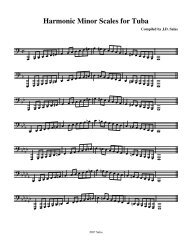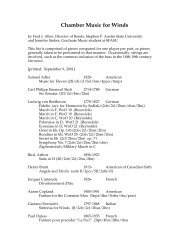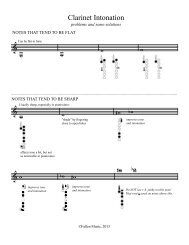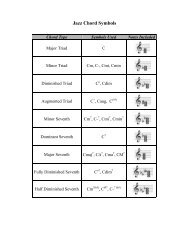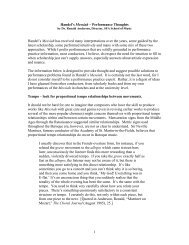Trombone Rep - History of the Trombone - Timeline 1 (EatonMensch ...
Trombone Rep - History of the Trombone - Timeline 1 (EatonMensch ...
Trombone Rep - History of the Trombone - Timeline 1 (EatonMensch ...
You also want an ePaper? Increase the reach of your titles
YUMPU automatically turns print PDFs into web optimized ePapers that Google loves.
<strong>History</strong> <strong>of</strong> <strong>the</strong> <strong>Trombone</strong><br />
P. 13<br />
Date Information Citation<br />
1706 A.D.<br />
1713 A.D.<br />
1713 A.D.<br />
1713 A.D.<br />
1714 - 1787<br />
A.D.<br />
1714 - 1787<br />
A.D.<br />
1714 - 1787<br />
A.D.<br />
1714 - 1787<br />
A.D.<br />
1714 - 1787<br />
A.D.<br />
1714 - 1787<br />
A.D.<br />
Friedrich Erhard Niedt provides a description <strong>of</strong> an 18th century trombone is his treaty<br />
Musicalischer Handleitung . He mentions a "bell section and <strong>the</strong> rods, which are placed in a<br />
sheath."<br />
Johann Math<strong>the</strong>son wrote a treatise, Das neu-er<strong>of</strong>fnete Orchestre , for <strong>the</strong> listening audience<br />
about instruments including <strong>the</strong> trombone.<br />
Mat<strong>the</strong>son: "Four trombones are specified, a small alto, a large alto, a tenor or "grosse-quart"<br />
and a bass trombone. Presuming <strong>the</strong> bass trombone to have been in F, <strong>the</strong> "grosse-quart"<br />
would refer to <strong>the</strong> B flat tenor instrument."<br />
"<strong>Trombone</strong>s, according to Mat<strong>the</strong>son, were seldom used except in churches and for solemn<br />
occasions."<br />
Guion p. 26-7<br />
Guion p. 25<br />
Carse p. 117<br />
Carse p. 117<br />
Gluck "added three trombones…to <strong>the</strong> standard pairs <strong>of</strong> horns and trumpets." Carse p. 156<br />
Horns and trombones appear in tutti sections <strong>of</strong> orchestral music by Gluck. "There is no<br />
attempt at any harmonic alliance between trumpets and trombones."<br />
"Alto, tenor and bass trombones are included only in particular movements <strong>of</strong> some <strong>of</strong><br />
Gluck's operas, and are used harmonically, with <strong>the</strong> parts placed close toge<strong>the</strong>r, and ra<strong>the</strong>r<br />
higher than is now customary."<br />
"It is noteworthy that Gluck's bass trombone by no means always sounds <strong>the</strong> bass note <strong>of</strong> <strong>the</strong><br />
chord; also that <strong>the</strong> traditional French custom <strong>of</strong> placing <strong>the</strong> trombone parts harmonically in<br />
close position seems to have its beginning in <strong>the</strong>se parts <strong>of</strong> Gluck."<br />
Gluck's trombone parts were occasionally written in unision. It is thought "that only <strong>the</strong> quiter<br />
manner <strong>of</strong> trombone-playing prevailed in <strong>the</strong> seventeenth and eighteenth centuries."<br />
"The addition <strong>of</strong> trombones had made a self-contained harmonic group <strong>of</strong> brass insruments<br />
quite feasible, and <strong>of</strong> <strong>the</strong> possible combinations, horns and trombones - such as are used in<br />
<strong>the</strong> well-known "Divinites du Styx" (Alceste) - are evidentally preferred to <strong>the</strong> bolder blend<br />
<strong>of</strong> trumpets and trombones."<br />
Carse p. 158-9<br />
Carse p. 159<br />
Carse p. 159<br />
Carse p. 159<br />
Carse p. 160<br />
1722 A.D. Bonanni describes an instrument as "Altra Tromba spezzata." Baines p. 104



![Finale 2008 - [Whole Tone Scales - Tuba.MUS]](https://img.yumpu.com/50937649/1/190x245/finale-2008-whole-tone-scales-tubamus.jpg?quality=85)

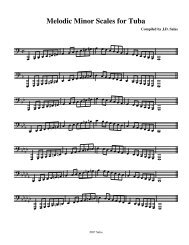
![Finale 2008 - [Chromatic Scales - Tuba.MUS]](https://img.yumpu.com/36500491/1/190x245/finale-2008-chromatic-scales-tubamus.jpg?quality=85)
